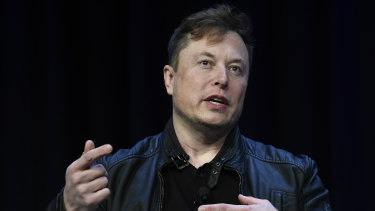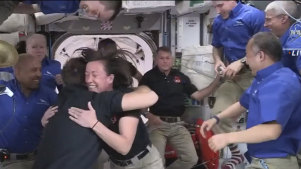‘Good news for internet users’: Elon Musk’s Starlink gets approval for satellites closer to Earth
By Chris Zappone
WA TODAY, AUSTRALIA
April 28, 2021 —
Elon Musk’s Starlink may be on the path to providing faster broadband to rural customers after a US ruling overnight allowed the company to operate part of its satellite fleet at a closer orbit to Earth.
The US Federal Communications Commission (FCC) on Tuesday (Wednesday AEST) granted Starlink the rights to orbit 2814 satellites - yet to be launched - in lower orbits than originally planned.

Play video 1:48 Starlink visualisation orbiting Earth
April 28, 2021 —
Elon Musk’s Starlink may be on the path to providing faster broadband to rural customers after a US ruling overnight allowed the company to operate part of its satellite fleet at a closer orbit to Earth.
The US Federal Communications Commission (FCC) on Tuesday (Wednesday AEST) granted Starlink the rights to orbit 2814 satellites - yet to be launched - in lower orbits than originally planned.

Play video 1:48 Starlink visualisation orbiting Earth
Starlink as it appears in a visualisation of satellites orbiting Earth. (Courtesy of Saber Astronautics).
Starlink, a division of SpaceX, currently has 1300 satellites in orbit, as part of a planned network of 12,000 designed to blanket the Earth with high-speed space-based internet broadband coverage.
The new ruling will bring the 2814 satellites from a planned orbit of about 1150 kilometres to about 550 kilometres, cutting down on the delay in the broadband signal.
“It’s going to be good news for internet users (including many test users in regional Australia) as lag will be reduced,” said Professor Alan Duffy, program lead for SpaceTech Applications at Swinburne University.
In making their ruling, the FCC concluded that “the lower altitude of its satellites enables a better user experience by improving speeds and latency”.

SpaceX founder Elon Musk.CREDIT:AP
Starlink’s latency - the time required to move data from source to destination - is expected to fall by mid 2021 from about 20 to 40 milliseconds to milliseconds measured in the teens or even single digits.
That compares with 600 to 800 milliseconds for the NBN Sky Muster satellites, orbiting at a much more distant 36,000 kilometres.
Advertisement
RELATED ARTICLE

NASA
Out of space: Astronauts ‘cram’ into space station after SpaceX crew arrives on used rocket
Starlink is among a handful of newly formed companies, including OneWeb and Amazon-backed Project Kuiper, that are offering broadband distributed by satellites in low-Earth-orbit. The technology, unproven at such scale, could potentially bridge the long-standing city-rural digital divide in Australia, the US and elsewhere. Australia has an estimated 2 million people who lack internet access at home.
Satellite-based broadband is made possible by combining existing technologies together in new ways. Starlink satellites are small and sent up in large batches by SpaceX rockets, which, being re-usable, make the cost of launch dramatically cheaper.
How these networks will function fully deployed is still unknown, including what sort of interference the competing networks could create for each other over time.
To gain FCC approval Starlink had to overcome objections by OneWeb, and Musk’s space rival, Jeff Bezos, whose Project Kuiper, which is also supporting an orbital-broadband network.
The companies cited the risk of interference as a reason to deny Starlink’s request.
“It is highly likely we will experience an interference issue at some point if all these satellites get up there,” Adelaide-based satellite designer engineer Julia Mitchell said.
Ms Mitchell, at satellite-manufacturer SITAEL Australia, said there were “hundreds of constellations planned”.
“Ultimately, there has not been a low-Earth-orbit constellation that has actually been profitable and not gone bankrupt at some point.
“Many start-ups fail, so [the companies lodging complaints with the FCC] now, may not actually be the people that put satellites up to offer internet services in the end,” Ms Mitchell said.
Starlink has about 320 customers in Victoria and New South Wales testing the equipment with another 7000 paid up and waiting for their gear, according to the Better Internet for Rural, Regional and Remote Australia site.
Professor Duffy said lower Starlink orbits will benefit astronomers by putting more of them into the Earth’s shadow, which “limits their reflection of sunlight that blind our optical telescopes”.
However, he’s not convinced thousands of new satellites won’t affect radio astronomy. “The biggest danger from the orbit is that it now sits much closer to crewed operations for the International Space Station as well as China’s future efforts with their own space station.”
The prospect of collisions is a threat to the overall safety of the orbit. This month a Starlink satellite nearly collided with a satellite operated by OneWeb, a UK-government-Bharti Global-backed internet satellite service.
Jason Held, chief executive of Sydney-based Saber Astronautics, which tracks satellites in orbit, said there was no real solution to “space traffic” issues today - which leads to near misses.
“It’s all barnstorming at the moment.”
Starlink, a division of SpaceX, currently has 1300 satellites in orbit, as part of a planned network of 12,000 designed to blanket the Earth with high-speed space-based internet broadband coverage.
The new ruling will bring the 2814 satellites from a planned orbit of about 1150 kilometres to about 550 kilometres, cutting down on the delay in the broadband signal.
“It’s going to be good news for internet users (including many test users in regional Australia) as lag will be reduced,” said Professor Alan Duffy, program lead for SpaceTech Applications at Swinburne University.
In making their ruling, the FCC concluded that “the lower altitude of its satellites enables a better user experience by improving speeds and latency”.

SpaceX founder Elon Musk.CREDIT:AP
Starlink’s latency - the time required to move data from source to destination - is expected to fall by mid 2021 from about 20 to 40 milliseconds to milliseconds measured in the teens or even single digits.
That compares with 600 to 800 milliseconds for the NBN Sky Muster satellites, orbiting at a much more distant 36,000 kilometres.
Advertisement
RELATED ARTICLE

NASA
Out of space: Astronauts ‘cram’ into space station after SpaceX crew arrives on used rocket
Starlink is among a handful of newly formed companies, including OneWeb and Amazon-backed Project Kuiper, that are offering broadband distributed by satellites in low-Earth-orbit. The technology, unproven at such scale, could potentially bridge the long-standing city-rural digital divide in Australia, the US and elsewhere. Australia has an estimated 2 million people who lack internet access at home.
Satellite-based broadband is made possible by combining existing technologies together in new ways. Starlink satellites are small and sent up in large batches by SpaceX rockets, which, being re-usable, make the cost of launch dramatically cheaper.
How these networks will function fully deployed is still unknown, including what sort of interference the competing networks could create for each other over time.
To gain FCC approval Starlink had to overcome objections by OneWeb, and Musk’s space rival, Jeff Bezos, whose Project Kuiper, which is also supporting an orbital-broadband network.
The companies cited the risk of interference as a reason to deny Starlink’s request.
“It is highly likely we will experience an interference issue at some point if all these satellites get up there,” Adelaide-based satellite designer engineer Julia Mitchell said.
Ms Mitchell, at satellite-manufacturer SITAEL Australia, said there were “hundreds of constellations planned”.
“Ultimately, there has not been a low-Earth-orbit constellation that has actually been profitable and not gone bankrupt at some point.
“Many start-ups fail, so [the companies lodging complaints with the FCC] now, may not actually be the people that put satellites up to offer internet services in the end,” Ms Mitchell said.
Starlink has about 320 customers in Victoria and New South Wales testing the equipment with another 7000 paid up and waiting for their gear, according to the Better Internet for Rural, Regional and Remote Australia site.
Professor Duffy said lower Starlink orbits will benefit astronomers by putting more of them into the Earth’s shadow, which “limits their reflection of sunlight that blind our optical telescopes”.
However, he’s not convinced thousands of new satellites won’t affect radio astronomy. “The biggest danger from the orbit is that it now sits much closer to crewed operations for the International Space Station as well as China’s future efforts with their own space station.”
The prospect of collisions is a threat to the overall safety of the orbit. This month a Starlink satellite nearly collided with a satellite operated by OneWeb, a UK-government-Bharti Global-backed internet satellite service.
Jason Held, chief executive of Sydney-based Saber Astronautics, which tracks satellites in orbit, said there was no real solution to “space traffic” issues today - which leads to near misses.
“It’s all barnstorming at the moment.”
No comments:
Post a Comment